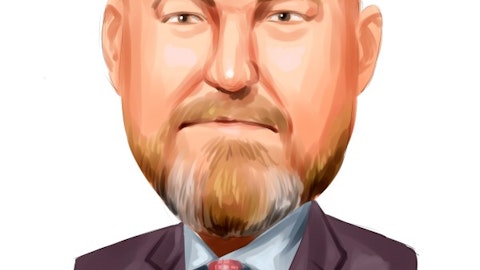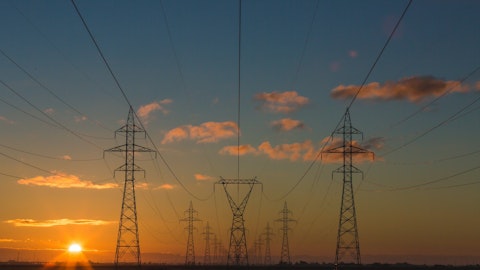Xcel Energy Inc. (NASDAQ:XEL) Q4 2022 Earnings Call Transcript January 26, 2023
Operator: Good day, ladies and gentlemen, and welcome to today’s Xcel Energy Year End 2022 Earnings Conference Call. For your information, today’s conference is being recorded. Questions will be taken from institutional investors, reporters can contact media relations with inquiries and individual investors and others can reach out to Investor Relations. At this time, I turn the conference over to your host today, Mr. Paul Johnson, Vice President, Investor Relations and Treasurer. Please go ahead, sir.
Paul Johnson: Good morning, and welcome to Xcel Energy’s 2022 fourth quarter earnings call. Joining me today are Bob Frenzel, Chairman, President and Chief Executive Officer; Brian Van Abel, Executive Vice President and Chief Financial Officer. In addition, we have other members of the management team in the room to answer questions if needed. This morning we will review our 2022 results and highlights and share recent business developments and regulatory developments. Slides that accompany today’s call are available on our website. As a reminder, some of our comments during today’s call may contain forward-looking information. Significant factors that could cause results to differ from those anticipated are described in our earnings release and our SEC filings.
Today, we will also discuss certain metrics that are non-GAAP measures. Information on the comparable GAAP measures and reconciliations are included in our earnings release. I’ll now turn the call over to Bob Frenzel.
Bob Frenzel: Thanks Paul, and good morning, everyone, and welcome to our fourth quarter call. We had another very successful year at Xcel Energy, continuing to execute on our strategy while delivering strong financial and operational performance. For our investors, we delivered EPS of $3.17 representing the 18th consecutive year of meeting or exceeding our initial earnings guidance. In February, we raised our annual dividend for 19th straight year increasing at $0.12 per share or 6.6%. More recently, in November, we extended our long-term investment plan which features a 10-year capital outlook with an approximate 7% rate base growth. We ranked in the top quartile in customer reliability or CAIDI and a residential electric bills are more than 20% below the national average.
And amidst the backdrop of significant commodity increases this year, Xcel Energy’s 4,500 megawatts of owned wind farms continued to be an industry-leader in net capacity factor performance, generated approximately $1 billion of fuel-related customer savings in 2022 and almost $3 billion since 2017. Our nuclear fleet remains the top performing fleet in the country and achieved a capacity factor of 96% last year. We had an active regulatory year and resolved multiple rate cases in Uri storm cost recovery proceedings. Commissions in Minnesota and Colorado approved resource plans that will add nearly 10,000 megawatts of utility scale renewables to our systems through this decade. The Minnesota Commission approved our 460 megawatts Sherco Solar project, the Colorado Commission approved our $2 billion Power Pathway transmission project and MISO awarded us $1.2 billion of transmission projects and we accelerated our timeline for transitioning out of coal and now expect to be coal free by the end of 2030, all of which contribute to our leadership in clean energy transition for our customers.
We continue to lead in carbon reduction as well. 2022, our estimated carbon emissions were approximately 52% below 2005 levels and we remain on track to achieve 80% carbon reduction across the company by 2030. The passage of the Inflation Reduction Act will reduce the cost of renewables for our customers, improves cash flow and credit metrics for the company and enhances the competitiveness of our renewable offerings. Continue to execute on our electric vehicle vision, implementing multiple new programs for our customers. We also filed comprehensive transportation plans in Minnesota and Wisconsin that are pending commission approval. We’ve advanced our ESG leadership and have been recognized by multiple entities, including an upgraded rating by MSCI from AA to AAA.
And finally, we remain among the world’s most ethical, admired and responsible companies and we’re recognized for being the best veteran employer as well for our disability inclusion in the workplace. I’m really proud to lead a team that can deliver on operational, financial, environmental and diversity goals, all simultaneously. Looking ahead, we’re well-positioned for sustainable organic growth over the next decade, including affordable renewable additions in our resource plans, the transmission needed to enable those carbon-free resources and responsible community transitions as we retire coal plants. We’ve recently issued a requests for proposals in Minnesota, Colorado and at SPS seeking approximately 6,000 megawatts of new renewable generation, a portion of the 10,000 megawatts that have been approved in our jurisdiction.
We’ll submit our recommended portfolios of generation assets to our commissions by the middle of this year and anticipate decisions in the second half of this year. We also expect to issue additional RFPs in Minnesota and Colorado this year and next year for the remainder of our approved needs. As we’ve discussed in the past, we believe that we have a geographical advantage in the clean energy transition due to the strong wind and solar resources in our service territory. This access to low cost renewable energy should also give us further advantage in developing green hydrogen and other clean fuel projects, which are becoming more feasible as a result of federal support from the Infrastructure and Jobs Act and the IRA. Late last year, we submitted hydrogen hub concept papers for both the Rocky Mountain and the Upper Midwest regions to the Department of Energy to compete for awards from the $8 billion hydrogen hub program.
In December, we received favorable notice from the DOE for our concepts and we’re encouraged to submit full applications in April. In addition, our pink hydrogen production pilot at our Prairie Island nuclear generating station is expected to be operational this year. Finally, we expect to bring forward opportunities this year to utilize clean fuels and green hydrogen blending at both our gas-fired generation stations and in our gas network for Home and Building heating. As we continue to utilize innovative technologies to decarbonize our business, we are well-positioned to take advantage of potentially significant hydrogen capital investment opportunities in the future. As the penetration of renewable assets in our states increases, we’re also interested in pursuing advanced storage opportunities to balance our electric system needs.
Today, we’re excited to announce a new partnership with Form Energy to develop two long-duration energy storage pilot projects. Form Energy’s 100-hour battery technology could be a critical component to our decarbonization strategy providing the resiliency and reliability that we need on the system to support our significant renewable portfolio. We plan to deploy a 10 megawatts multi-day storage system at a retiring coal plant in both Minnesota and Colorado. These projects are expected to be online as early as 2025. And as we wrap up, I want to thank the thousands of employees who worked in below zero temperatures, sustained high winds in several feet of wet, heavy snow, keep the lights on and the houses warm during our recent winter storms.
Your efforts exemplify our company values of connected, committed, trustworthy and safe, and I believe that our dedicated employees and partners are what distinguishes Xcel Energy with our customers. With that, I’ll turn it over to Brian.

Photo by David Thielen on Unsplash
Brian Van Abel: Thanks Bob. Good morning, all. We had another strong year recording earnings of $3.17 per share for 2022 compared with $2.96 per share in 2021. This represents EPS growth of 7.1%, slightly above our long-term growth rate target of 5% to 7%. The most significant earnings drivers for the year included the following; higher electric and natural gas margins increased earnings by $1.05 per share, primarily driven by regulatory outcomes and riders to recover capital investments. In addition, a lower effective tax rate increased earnings by $0.15 per share, but keep in mind, production tax credits lowered the ETR, PTCs are flowed back to customers through lower electric margin are largely earnings neutral. Offsetting these positive drivers were increased depreciation expense which reduced earnings by $0.40 per share reflecting our capital investment program, higher O&M expense which decreased earnings by $0.24 per share, higher interest expense and other taxes, primarily property taxes, decreased earnings by $0.23 per share and other items combined to reduce earnings by $0.12 per share.
Turning to sales, our weather-adjusted electric sales increased by 1.8%, largely due to higher C&I sales driven by strong economic activity in our service territories. We anticipate a modest slowing of our sales with growth of 1% in 2023. Shifting to expense, O&M expenses increased $170 million for the year, driven by cost related to technology and customer programs, storms, vegetation management inflation and additional actions due to weather. We also invested in our employees, ensure we retained our top talent. While we expect inflationary pressures to remain, we continue to focus on our continuous improvement programs, which we expect to drive increased productivity and efficiency. As a result, we anticipate O&M expenses will decline approximately 2% in 2023.
We made progress on a number of regulatory proceedings. In the Minnesota Natural Gas rate case, the ALJ recommended the commission approve our settlement which reflects a rate increase of $21 million, an ROE of 9.57% and equity ratio of 52.5%, the decoupling mechanism and a property tax tracker. We anticipate a commission decision later this year. In the Minnesota electric rate case, the commission accepted our proposal to reduce our requests from MISO capacity revenue and establish our tracker. Hearings were completed in December and we continue to meet with the parties to see if we can reach a constructive settlement. However, we have a strong case and are comfortable with a fully litigated outcome absent this settlement. We anticipate a commission decision later in 2023.
In November of 2022, we filed an electric rate case in Colorado seeking a net increase of $262 million based on an ROE of 10.25% and equity ratio of 55.7% in a 2023 forward test year. We anticipate a commission decision and implementation of final rates in the third quarter. We also filed a New Mexico electric rate case seeking a rate increase of $78 million based on an ROE of 10.75%, equity ratio of 54.7%, the forecast touch here in the early retirement of the Tolk coal plant. We anticipate a commission decision and implementation of final rates in the fourth quarter. As far as future filings, we plan to file our Texas rate case later in the quarter and Wisconsin in the second quarter. As we have discussed in the past, the Inflation Reduction Act provides significant customer benefits, key elements include the following; tax credit transferability will provide $1.8 billion of liquidity increasing cash flow and reducing equity needs.
We’ve met with companies in our service territory and expect to enter into bilateral tax credit sale contracts later this year. Our FFO to debt metrics improved by 100 basis points during the forecast period, the solar PTC and tax credit transferability improve the competitiveness of our renewable bids and we anticipate pricing will decline in solar projects by 25% to 40% in wind projects by 50% to 65% due to the new and extended tax credits, which is great for our customers as we embark on this clean energy transition. Finally, we don’t anticipate any material impact from AMT as a result of makers’ depreciation and existing tax credits on our balance sheet. We are reaffirming our 2023 earnings guidance range of $3.30 to $3.40 per share, which is consistent with our long-term EPS growth objective of 5% to 7%.
We have updated our key assumptions to reflect actual year-end results which are detailed in our earnings release. With that, I’ll wrap up with a quick summary. We had a strong operational and financial year in 2022. We delivered 2022 earnings within our guidance range, the 18th consecutive year and increased our dividend for the 19th consecutive year. We received approval of our research plans in Colorado and Minnesota, which results in approximately 10,000 megawatts of new renewables. The Inflation Reduction Act has passed a significant benefits for our customers in the company. We are reaffirming 2023 guidance, consistent with our long-term earnings growth rate. We remain confident we can continue to deliver long-term earnings and dividend growth within the upper half of our 5% to 7% objective range as we lead the clean energy transition and keep bills low for our customers.
This concludes our prepared remarks. Operator, we will now take questions.
See also 11 Best Performing S&P 500 Stocks in 10 Years and 11 Most Undervalued Bank Stocks.
Q&A Session
Follow Xcel Energy Inc (NYSE:XEL)
Follow Xcel Energy Inc (NYSE:XEL)
Operator: First question is coming from Mr. Nick Campanella calling from Credit Suisse. Please go ahead. Your line is open, sir.
Nick Campanella: Hi, thanks for taking the question. So, I guess just on the O&M and the ’23 guide that really stuck out to us and I heard some of your comments in the prepared remarks just talking about continuous improvement. Can you maybe just give us a little bit more on what levers you’re pulling that’s leading to that O&M reduction and is this — we are more one-time in nature at ’23 or sustainable through the plan? Thank you.
Brian Van Abel: Hi, Nick. Yes, good question. In a couple — let me make a couple of points out, one is a little bit of a function of where actuals in 2022 ended up in terms of updating our 2023 O&M guidance, but we’re really proud of the continuous improvement efforts that we’ve had underway and they’ve been underway for a long-time from 2014 to 2021, we kept O&M flat and that’s something I’m really proud of our employees for doing and really good benefit to our customers. We did have inflationary pressures in 2022 but also took actions given the good weather year to reinvest in 2022 and this is similar with our employees. As I think about 2023, couple of things, one is, now we’re investing a lot in technology and how do we make us more efficient in our plants, we have some of the digital operations factory which is really using AI in our plants to move from more reactive, proactive maintenance.
We’re investing significantly in, call it, real time scheduling in other opportunities to use AI. We also are starting to get on a treadmill of shutting down our coal plants, we have a broader coal unit a year that will start to shut down which provides us with a tailwind as we think not only in ’23 but through basically the end of this decade in terms of as we lead this clean energy transition. And then we also do see some abatement of, call it, the high diesel costs, we had a storm year that was above normal in 2022, for example, we had quintuple the number of storm days in December. So there are some things that happened in ’22 that won’t happen in ’23 that should help us achieve it. So, a long answer, but a lot there to unpack and hopefully that helped provide some color on it.
Nick Campanella: Yes, that’s great. Thank you so much. That’s helpful. And on the Minnesota electric case, it sounds like you’re confident in taking this the full distance to in order of, but I just wanted to be clear, is the settlement more unlikely at this point and how should we be thinking about that taking into consideration, where we are on the docket today?
BobFrenzel: Nick, it’s Bob, thanks for the question. And as we said in the prepared remarks, we filed this case over a year-ago, we probably actively working with parties since the September timeframe and we’ve reduced our total initial ask dramatically through extension of asset lives through the MISO capacity revenues and for bringing down the actual sales that we experienced in the state. So we think that reduced revenue ask is really a tailwind for us in the case, there’s probably some pretty decent — recent decisions in Minnesota, Southern Minnesota Power case the other day in our gas settlement that Brian mentioned in his prepared remarks are data points that we feel confident in taking this, as you say, all the way, but we’re always open to engaging with all the parties and if there is an opportunity to move forward with a settlement, we would certainly think to do so.
Operator: Thank you very much, sir. We now go to David Arcaro calling from Morgan Stanley. Please go ahead.
David Arcaro: Thanks so much for taking my questions. I was wondering if you might be able to give any preview of what we could expect from the Clean Heat Plan filing later this year in Colorado, whether there might be potential CapEx investments additions to the plan and what new technologies and opportunities that might be to invest there?
BobFrenzel: Hi, David, it’s Bob. That’s a great question. Look, we’re excited about the Clean Heat Plan opportunity, it’s really an opportunity for us I think to share and align our vision for a net zero future on the gas business with our commissions in a more formal way. I’m not certain that I would expect to see a significant amount of sort of new investment opportunities as part of that process, but really an opportunity to align on our multipronged strategy to decarbonize the gas business. As I think about it, we’re working with upstream providers to reduce methane on the purchase gas that we buy for our customers. We’re working on our own system, we have been for over the past decade in methane leak reduction, we’ve done a terrific job there, but there is always more to work to tighten up our own system and then we work on customer programs that encourage energy efficiency that encourage maybe fuel switching and beneficial electrification and then I think the big opportunity from an investment perspective is really the comments I made around clean fuel in my prepared remarks.
We are working with multiple parties in the Colorado jurisdiction on a Rocky Mountain hydrogen hub, we think it’s a really attractive project, a multistate MOU has been signed with several of the Western states and the governors and all the energy officers of the states are working together. So I think clean fuel’s a real opportunity for us and for our customers to advance the clean energy transition and to help us realize a net zero future in the gas business.





